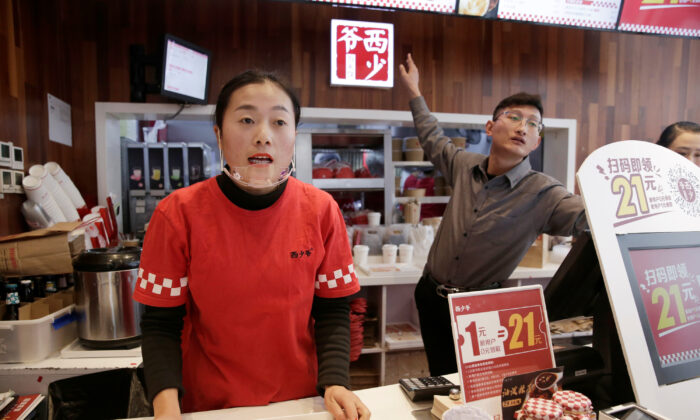Chinese City Halts Plan for Crematorium After Clashes Between Locals and Police
BEIJING—Cao Xianli, the owner of a “ribs and rice” restaurant in eastern China’s Qingdao City, is facing his biggest test in a decade of running the eatery.
Not only have costs doubled in the last year because of soaring pork prices, but he’s not even sure he’ll be able to secure enough of the meat needed for his signature dish.
“My concern is how much longer I will still be able to buy pork. If I can’t buy pork, I have to close my shop,” Cao told Reuters.

China’s rocketing pork prices come after a deadly disease ravaged its huge hog herd, leaving the world’s top consumer of the meat short of about a quarter of its usual supplies. That’s about 13.5 million tonnes, more than the entire pork production of the United States.

With pork by far the most popular meat in China, food inflation is running at its highest in almost eight years, surprising both seasoned economists and restaurateurs.
“In the past year, both we and the market underestimated the pace of pork price inflation,” wrote analyst Lu Ting and colleagues at Japanese bank Nomura in an October report, revising up their forecast for inflation next year.
Purchasing Power
Sky rocketing pork prices are impacting the entire supply chain. Wholesale chicken prices are up 33 percent on a year ago, driven by wide-scale substitution of pricy pork with cheaper poultry, meaning China’s popular fried chicken chains are also feeling the heat.
Industry leader KFC has managed the surge in costs by forcing suppliers to take much of the hit, keeping inflation under 10 percent, executives with the firm’s owner Yum China Holdings said on an Oct. 28 earnings call.
To absorb the rest of the increase, KFC has increased the number of non-chicken items on its menu, adding a duck meat wrap and a portobello mushroom burger. Duck is China’s cheapest meat.
KFC is also using cheaper chicken parts, replacing wings with “strips” of breast meat, and offering a “wing tip bucket” in July and again in October.
Though little more than skin, bone and cartilage at the end of the chicken wing, the fried wing tips proved popular, said chief executive Joey Wat on the recent call. “There are a group, not a huge group, but there’s still a group of people who just love it,” she told analysts.
The company warned that 2020 will be “another challenging year for commodity inflation” but said it will be “prudent” on the portion of costs passed on to customers.
No Room to Diversify
The millions of smaller players in China’s 4 trillion yuan ($568 billion) catering sector have fewer options to cope with soaring costs and limited supplies.
Though imports have surged this year, an expected 3 million tonnes of pork from abroad can’t plug domestic needs, and Beijing only has small volumes of frozen pork in state reserves.
“The impact on us is huge. We sell ribs, that’s it. For us, there is no room for diversification,” said Cao, owner of the Qingdao restaurant.
Cao hiked his prices by about 10 percent to 19 yuan per serving and managed to retain his customers. “People still come as they also have no choice. If they go to the market to buy pork, they’ll find it’s no cheaper,” he said.
 A customer eats a baked bun with chicken at a pork bun chain restaurant Xishaoye in Beijing, China on Nov. 22, 2019. (Jason Lee/Reuters)
A customer eats a baked bun with chicken at a pork bun chain restaurant Xishaoye in Beijing, China on Nov. 22, 2019. (Jason Lee/Reuters)But others have struggled to keep customers while raising prices. Xishaoye, a Beijing-based chain that specializes in “roujiamo,” the traditional Chinese pork bun, had to lower prices again after a small hike hurt business, said Ji Chen, a manager at one of the chain’s outlets.
“It’s a highly competitive market, you can’t raise your price more than by a low single-digit,” said Lina Yan, consumer analyst at HSBC. Xishaoye has resorted to promoting chicken and vegetable variants of the pork bun, and offering a set menu with pork-free side dishes to steer customers away from their bestselling item.
That helped to halve pork consumption at their 43 restaurants but it has still racked up losses of more than 6 million yuan this year, said chief executive Meng Bing.
“Ingredients usually account for about 30-40 percent of costs, so if the cost of ingredients increases by 20 percent to 30 percent, the company is highly likely to lose money,” said Meng.
China’s Vice Premier Hu Chunhua has urged farmers to restock empty farms and called on provincial authorities to do all they can to guarantee pork supplies, particularly ahead of the important Lunar New Year holiday next month.
The agriculture ministry says pig production should return to about 80 percent of normal levels by late 2020, but many others believe that forecast is overly optimistic, particularly as swine fever is still spreading.
After dipping last month, pork prices are rising again and even larger companies could come under greater pressure if inflation doesn’t soon subside.
An executive with one of China’s largest mass-market catering companies said it may soon be forced to raise prices.
“Increasing the price is really the last resort as our consumers are price-sensitive. But if pork prices stay high in 2020, we will have no choice,” he said, declining to be identified because pork supplies are a sensitive topic.
By Sophie Yu and Dominique Patton
This article is from the Internet:China’s Restaurants Feel the Heat as Pork Supplies Plunge
